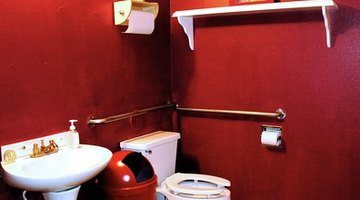How to Install a Toilet Flange in Lead Pipe
Old houses can be a hassle to maintain. And lead sewer lines can be one of these repair headaches if old toilets have to be replaced. Converting the end of the lead line to fit a standard toilet flange isn't an impossible task though, and a little ingenuity can take care of the issue without requiring you to replace all the lines in your home.

-
Cut the lead pipe to one inch below the level of the sub-floor, making sure the cut is level.
-
Push the instant set closet flange down onto the vertical lead sewer pipe until the flange screw holes rest on the sub-floor. Screw the flange to the sub-floor. The toilet is now ready for installation (follow the steps below if the lead sewer pipe is more than one inch below the sub floor).
-
Measure the distance from the top of the lead sewer line to one inch below the surface of the sub-floor. Cut a piece of 4-inch PVC sewer line to that length.
-
Place the rubber flange down over the old lead sewer line, then push the cut PVC sewer pipe down on top of the rubber flange. Connect the rubber flange to both the old lead line and to the new PVC line by tightening the clamp screws.
-
Prime the top of the PVC sewer line, as well as the bottom of the flange. Wait for the primer to dry before applying PVC glue to both primed areas, and push the flange down onto the PVC line. Screw in the flange to the sub-floor. The toilet is now ready for installation.
References
Tips
- If the old lead sewer line is one inch below the sub floor, no cutting of the old pipe is necessary.
- Check that the old lead sewer line is working well. It may have to be replaced entirely, of if a leak occurs close to the toilet, new PVC sewer line can be attached by cutting the old lead line before the leak, and adding a rubber flange to join the old line to the new.
Writer Bio
Steve Sloane started working as a freelance writer in 2007. He has written articles for various websites, using more than a decade of DIY experience to cover mostly construction-related topics. He also writes movie reviews for Inland SoCal. Sloane holds a Bachelor of Arts in creative writing and film theory from the University of California, Riverside.
Photo Credits
- red bathroom image by Jeffrey Sinnock from Fotolia.com
More Articles



